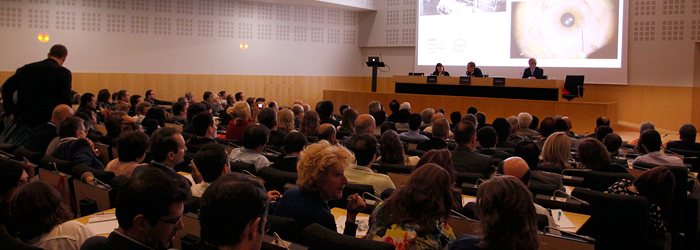The conference will see the world's leading lights in the speciality in attendance and will see eight procedures being retransmitted live from IMO theatres
Next Friday 7 and Saturday 8, over 300 ophthalmologists from around the world will attend an international retina conference organised by the Barcelona Institute of Ocular Microsurgery (IMO) under the title “Trends in Surgical and Medical Retina”. The speakers include the most renowned international specialists such as doctors Mark Blumenkranz, Gisbert Richard, Stanley Chang and Borja Corcóstegui, IMO's medical director and the meeting's organiser, which saw its first edition held in 2011.
During the meeting, the specialists will discuss the key new developments in the treatment of diseases of the retina, a thin layer of nerve tissue covering the eye's internal structure and in which the most serious ocular pathologies occur. Among the developments attracting most interest in this field and which will be discussed during the conference, is the use of stem cells to treat diseases such as AMD (age-related macular degeneration) or diabetic retinopathy; robotic surgery, with the incorporation of new surgical systems programmed to perform mechanical tasks traditionally carried out by the surgeon; or artificial vision through micro-chip development or electrical stimulation of the retina, the result of several decades of development in numerous countries worldwide.
According to Dr Borja Corcóstegui, “the retina is a very interesting area for conferences of this type, given its high incidence in ocular health, vision and quality of life and also considering that there is still a long way to go. We are exploring new treatment possibilities that were unimaginable a few years ago”. One of these is the application of intraocular injections that release drugs into the eye over weeks or months and which provide increasingly better results for problems such as macular degeneration, retinal vein obstruction and diabetic retinopathy. Around 60% of treated patients recover their vision compared with 20% with other techniques. “In addition, this treatment avoids risks associated with surgery, which have reduced by almost half in recent years", explains the specialist.
The Conference's director also highlights the speed at which progress has been made in genetic research ias regards retinal complications, many of which are caused by a combination of environmental factors and genetic predisposition. According to Dr Borja Corcóstegui, “we are working towards discovering the molecular bases of the different ocular pathologies to provide genetic diagnosis, get to know each patient's prognosis better and lay the foundations for future genetic therapies, which are now starting to become a reality. Among others, we have already located 2 genes responsible for more than half of retinal diseases. If we are able to change these affected parts of the genetic code with parts that are unaffected, we will have the key to curing many retinal diseases”.
Gene therapy is already very advanced in diseases such as Stargardt, the most common of the degenerative retinal pathologies that occur at a young age, or diabetic retinopathy, with works for inducing protector molecules in the retina of these patients.
Live surgery
In line with these developments, surgical treatment remains the key to solving retina problems. Therefore, the conference will show 8 procedures from 4 of the 9 IMO operating theatres, which will be screened live in the auditorium, from where the attendees can follow and comment on the most up-to-date techniques used by the experienced team of ophthalmologists performing the procedures. The aim is to show the biggest surgical developments, highlighting the refinement of techniques and the introduction of smaller-sized instruments.
